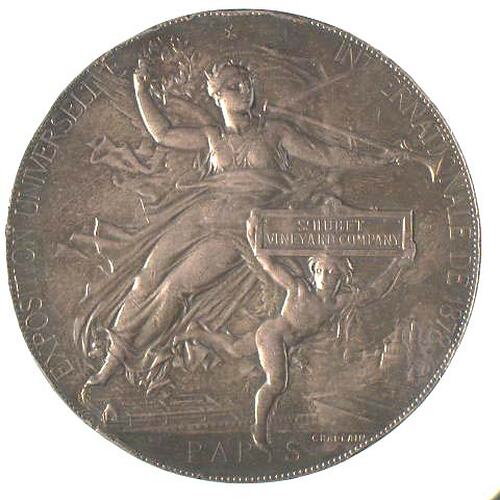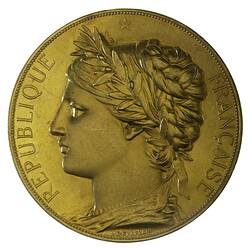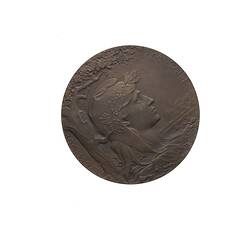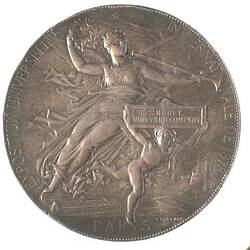Jules-Clement Chaplain designed a medal for the Paris Exposition Universelle Internationale Gold Prize. This medal marks the emergence of Art Nouveau design in medals. Chaplain retained the basic neo-classical themes - including Victory bearing a wreath - but his depiction is rich with movement and his composition emerges from the background in flowing lines. Chaplain was one of the most significant of a group of Parisian medallists who adapted their designs to make maximum use of new reduction technology, locating Paris once again at the centre of the medallic world.
Chaplain also designed a portrait of Victor Hugo, commemorating the centenary of his birth in 1902. It is an excellent example of the reducing machine at work, retaining the detail of the large-scale work.
Chaplain was born in 1839 and won the Prix de Rome at the age of 24, in 1863. Five years later he returned to Paris, where he found official success almost immediately, winning notice in the Salons of 1870 and 1872. By 1877 he was named the official medallist of the French government; in 1878 he was a chevalier of the Legion of Honor; and in 1881 was given the seat at the Académie des Beaux Arts. He was responsible for the official portraits of every president of the French Republic from Edme Patrice Mac-Mahon in 1877 to Émile Loubet in 1899. He was commissioned to engrave the gold coinage of France, and his gold medal commemorating the visit of Czar Nicholas and Czarina Alexandra of Russia to Paris in 1896 was thought to be one of the finest ever struck.
However, it is his cast portrait medals that constitutes his great achievement as an artist. By the late 1870s Chaplain had developed an intimate and realistic style of portraiture, allowing his portraits to emerge from and interact with the surrounding field and establishing his compositions with a series of free and sweeping lines. Beginning with his portrait of the medallist Auguste Barre in 1879, Chaplain executed a series of some 20 cast medals representing prominent artists and architects of his day. Chaplain was one of the first artists to produce models for cast medals that were equally effective when reduced in size and struck. This had the effect of blurring the traditional distinctions between these two techniques and opening, by the end of the 19th century, medallic art to increased experimentation by artists who did not necessarily follow Chaplain's conventional career path.
References:
Shaples, J. (1990). 'Medals as Art: Australia and the Meszaros Tradition', Journal of the Numismatic Association of Australia, p.18.
David and Constance Yates, New York, 1997 website http://www.dcyates.com/medals/article.htm, accessed 06 Jan 2004.
More Information
-
Keywords
-
Localities
-
Authors
-
Article types



